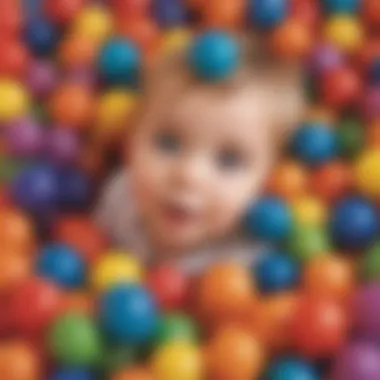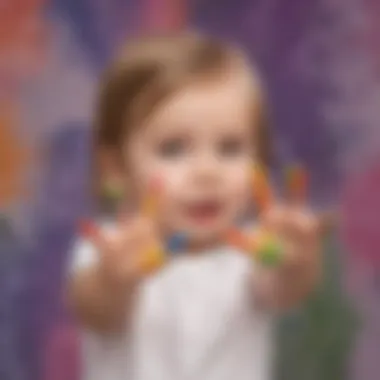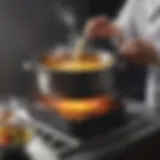Unlocking the Benefits of Sensory Play for 2-Year-Olds: A Comprehensive Guide


Science Fun Facts
Sensory play is an essential aspect of early childhood development. Did you know that engaging in sensory activities can enhance cognitive, social, and emotional growth in 2-year-olds? These activities allow toddlers to explore the world around them using their senses, promoting creativity and curiosity! Imagine the joy on a child's face as they squish playdough between their fingers or feel the softness of a feather - these experiences are not just fun but also crucial for their overall development!
Discover the Wonders of Science
Explore the magic of sensory play with your 2-year-old! By engaging in sensory activities, children can learn about textures, colors, sounds, and smells, stimulating their brain and fostering a love for learning. Watch educational videos together to introduce new sensory experiences or create DIY sensory bins using materials like rice, water, or kinetic sand. Encouraging your child to engage in sensory play can lay a strong foundation for their future academic success and social skills!
Science Quiz Time
Challenge your knowledge with fun and interactive sensory play quizzes! Test your understanding of different sensory materials, colors, and textures through engaging multiple-choice questions. Can your 2-year-old guess which sensory item makes a squishy sound or which feels prickly to touch? These brain teasers not only make learning fun but also provide valuable insights into your child's sensory preferences and cognitive development. Get ready for a delightful journey of discovery and learning through gamified sensory play!
Science Experiment Showcase
Ready to dive into hands-on sensory play experiments? Gather materials like ice, jello, or scented playdough to create exciting sensory opportunities for your child. Follow simple step-by-step instructions to set up safe and engaging experiments that enhance your toddler's tactile exploration and sensory awareness. Remember to prioritize safety by supervising closely, especially when dealing with small objects or liquids. These sensory experiments are not just play but also valuable learning experiences for your curious 2-year-old!
Introduction to Sensory Play
Sensory play holds paramount significance in the developmental journey of young children, especially 2-year-olds. It serves as a foundational pillar in nurturing a child’s cognitive, social, and emotional capacities. Sensory play ignites the young minds to actively explore and engage with the world around them, creating a fertile ground for curiosity and learning. This section delves into the pivotal role of sensory play in laying a robust framework for a child's overall growth and development.
Defining Sensory Play
Sensory play is a dynamic educational approach that encourages children to engage in activities that stimulate their senses – sight, touch, smell, taste, and hearing. It involves providing children with opportunities to explore various materials, textures, and environments through sensory-rich experiences. These experiences not only awaken the senses but also promote cognitive development and creativity in young minds. Sensory play is not just about getting messy; it is a structured way for children to make sense of the world around them.
Importance of Sensory Play
The importance of sensory play lies in its multifaceted benefits for a child's holistic development. Through sensory play, children are not only entertained but also engage in meaningful learning experiences. It helps enhance cognitive functions, fine and gross motor skills, language development, and problem-solving abilities. Additionally, sensory play fosters social interaction and emotional regulation in children by providing a safe space for expression and exploration. It serves as a natural way for children to learn, grow, and discover their capabilities in a nurturing environment.
Benefits of Sensory Exploration
The exploration of sensory activities offers a myriad of benefits to 2-year-olds. By engaging in sensory play, children develop enhanced sensory awareness, critical thinking skills, and creativity. Sensory exploration aids in language development, as children articulate their sensory experiences verbally. Moreover, it promotes sensory integration, enabling children to effectively process and respond to sensory information from the environment. Overall, sensory exploration is a powerful tool that enriches a child's learning experience and contributes significantly to their cognitive and emotional growth.
Sensory Play Activities for 2-Year-Olds
Sensory play activities for 2-year-olds are crucial for their development. These activities stimulate various senses, aiding in cognitive, social, and emotional growth. By engaging in sensory play, toddlers can enhance their creativity and curiosity. The different sensory play activities outlined in this article cater to the specific needs and interests of 2-year-olds.
Introduction to Edible Sensory Bins
Introducing edible sensory bins to toddlers introduces them to tactile exploration through safe, edible materials. This sensory play activity allows 2-year-olds to engage taste alongside touch, sight, and smell. The textures of varied food items inside the bins provide a sensory-rich experience. Despite their messiness, edible sensory bins are a popular choice among parents and caregivers for their versatility and sensory stimulation benefits.
Safety Considerations


Safety considerations play a pivotal role in sensory activities for toddlers. Ensuring that edible items are age-appropriate and hypoallergenic is essential. Additionally, close supervision while children engage in edible sensory play is vital to prevent choking hazards or allergic reactions. While safety is a primary concern, the sensory play experience should also be enjoyable and enriching.
Ideas for Edible Sensory Bin Fillers
Ideas for edible sensory bin fillers encompass a range of food items with diverse textures, colors, and tastes. Some popular fillers include cooked pasta, cereal, soft fruits, and vegetables. These items offer a mix of smooth, crunchy, and squishy textures for toddlers to explore. While selecting fillers, considering nutritional value and potential allergens is crucial. Incorporating a variety of fillers ensures a well-rounded sensory experience for 2-year-olds.
Sensory Bottles
Sensory bottles are engaging for toddlers, providing visual and auditory stimulation. Crafting sensory bottles requires simple materials and encourages creativity. These bottles can contain items like glitter, beads, or water, captivating the senses through movement and color. In this article, we delve into comprehensive instructions for making sensory bottles tailored to the preferences of 2-year-olds.
How to Make Sensory Bottles
Understanding the process of making sensory bottles is essential for creating an enriching sensory play experience. Carefully selecting materials that are safe and visually appealing is key. The process involves filling a clear plastic bottle with a combination of water, glitter, and other sensory items. By sealing the bottle securely, toddlers can safely interact with the sensory elements within, providing a mesmerizing sensory experience.
Variations and Themes
Introducing variations and themes to sensory bottles adds an element of novelty and customization. Different themes, such as nature-inspired or color-focused bottles, cater to varying sensory interests. Additionally, incorporating diverse items like feathers or pebbles provides a tactile and visual delight. Adapting sensory bottles based on themes can make the play experience more engaging and educational for 2-year-olds.
Benefits of Sensory Bottles
Sensory bottles offer numerous benefits for 2-year-olds, including calming effects and sensory exploration. These bottles can serve as tools for self-soothing and focus enhancement. The variety of colors and textures within the bottles stimulate visual perception and curiosity. Incorporating sensory bottles into a child's routine can foster sensory development and provide a calming sensory retreat.
Texture Play
Texture play is a fundamental sensory activity that helps toddlers explore and differentiate between tactile sensations. By engaging in texture play, 2-year-olds refine their fine motor skills and expand their sensory vocabulary. The activities under texture play are designed to encourage children to touch and feel various materials, promoting sensory integration and cognitive development.
Exploring Different Textures
Exploring different textures through materials like sandpaper, fabric, and cotton balls allows toddlers to distinguish between rough, smooth, soft, and hard surfaces. This form of sensory play aids in sensory discrimination and cognitive understanding. Providing a variety of textures for exploration enhances the child's sensory processing abilities and enriches their sensory play experiences.
Creating Texture Boards
Creating texture boards for toddlers involves assembling materials of contrasting textures onto a board or surface. This activity stimulates tactile exploration and encourages sensory comparison. Texture boards enable 2-year-olds to independently touch and feel different textures, fostering sensory curiosity. Customizing texture boards with a mix of materials allows children to engage in meaningful sensory interactions.
Learning Through Texture
Learning through texture engages multiple senses simultaneously, enhancing cognitive processing and sensory awareness. By incorporating texture-based activities into play, toddlers can strengthen their neural connections. Exploring textures aids in memory retention and promotes sensory integration. Providing opportunities for learning through texture can significantly contribute to a child's holistic development.
Nature Exploration
Nature exploration offers a diverse sensory experience for toddlers, connecting them with the natural world. Outdoor sensory activities expose children to unique environmental stimuli, fostering a deeper appreciation for nature. By incorporating nature-inspired elements into sensory play, 2-year-olds can engage in multisensory learning experiences that promote curiosity and environmental awareness.


Outdoor Sensory Activities
Outdoor sensory activities provide a rich sensorial experience, allowing toddlers to interact with natural elements like soil, leaves, and water. These activities encourage tactile exploration and sensory engagement in a natural setting. By venturing outdoors, children can develop a strong connection with nature while honing their sensory skills. The benefits of outdoor sensory activities extend beyond physical well-being, nurturing a child's innate sense of wonder.
Bringing Nature Indoors
Bringing elements of nature indoors enables 2-year-olds to engage with natural materials in a controlled environment. This indoor nature exploration offers sensory stimuli while ensuring safety and accessibility. By incorporating natural elements like rocks, plants, or seashells into sensory play, children can experience the textures and scents of the outdoors within their homes. Indoor nature exploration fosters a sense of environmental connection and sensory enrichment.
Nature-Inspired Sensory Play Ideas
Nature-inspired sensory play ideas infuse elements of the natural world into sensory activities, sparking curiosity and creativity. By integrating themes like beach play, forest exploration, or garden-inspired setups, toddlers can engage in imaginative and multisensory play experiences. Nature-inspired sensory play provides a unique avenue for 2-year-olds to connect with their surroundings and develop a deep appreciation for nature.
Guiding Principles for Sensory Play
Sensory play holds a pivotal role in the development of young minds, particularly in the formative years of a toddler's life. Our exploration delves deep into the guiding principles that underscore sensory play for 2-year-olds, shedding light on its intrinsic value and impact. By prioritizing sensory activities tailored to young children, we pave the way for a rich and immersive learning experience that transcends traditional teaching methods.
Elucidating on the importance of guiding principles in sensory play for toddlers, we find that establishing a solid framework based on safety, exploration, and environment sets the stage for optimal development. By adhering to these principles, caregivers can create a nurturing space conducive to holistic growth and learning.
Safety Precautions
Within the realm of sensory play, safety stands as a cornerstone principle that cannot be overlooked. Implementing appropriate safety precautions ensures that children can engage in activities without unnecessary risks or hazards. Careful consideration must be given to age-appropriate materials, non-toxic components, and supervision to safeguard against potential dangers. By integrating safety measures into sensory play sessions, caregivers can foster an environment where children can explore and discover with peace of mind.
Encouraging Exploration
Encouraging toddlers to explore their senses is a fundamental aspect of sensory play. Through open-ended activities that stimulate curiosity and creativity, caregivers can nurture a child's natural inclination towards discovery. By embracing the spirit of exploration, children can cultivate vital skills such as problem-solving, critical thinking, and adaptability. Encouraging a sense of wonder and engagement paves the way for enriching sensory experiences that shape cognitive development.
Creating a Sensory-Friendly Environment
The environment in which sensory play takes place plays a significant role in shaping the overall experience. By creating a sensory-friendly space, caregivers can optimize the benefits of sensory activities for 2-year-olds. Factors such as lighting, noise levels, and access to materials all contribute to crafting a conducive setting for exploration. By designing an environment that caters to a child's sensory needs, caregivers can amplify the impact of play experiences, leading to enhanced learning and growth.
Benefits of Sensory Play for Development
Exploring sensory play at a young age is fundamental in nurturing a child's holistic development. This section comprehensively elaborates on the pivotal role sensory play performs in fostering cognitive, social, and emotional growth in 2-year-olds. Through engaging in sensory activities, children at this tender age embark on a journey of exploration and learning that magnifies their understanding of the immediate world around them. Sensory play instills in toddlers a deep sense of creativity, igniting their curiosity and inquisitiveness.
Cognitive Development
Cognitive development in toddlers is significantly influenced by sensory play experiences. As children interact with various textures, sounds, and stimuli during sensory play, their cognitive abilities are rigorously challenged and enhanced. Through hands-on exploration and manipulation of materials, toddlers sharpen their problem-solving skills, critical thinking abilities, and memory retention. Furthermore, sensory play aids in the development of sensory processing skills, sharpening a child's ability to interpret and respond to the stimuli around them.
Social and Emotional Growth
Sensory play acts as a catalyst for profound social and emotional growth in 2-year-olds. By engaging in sensory activities with peers or caregivers, children learn important social skills such as sharing, communication, and collaboration. Moreover, sensory play offers a safe space for children to express and regulate their emotions. Through tactile experiences and sensory stimulation, toddlers learn to manage feelings of frustration, excitement, or calmness, fostering emotional intelligence and resilience.


Fine and Gross Motor Skills
The development of fine and gross motor skills is intricately linked to sensory play engagements. Fine motor skills such as hand-eye coordination, dexterity, and grasp strength are honed through activities like manipulating small objects in sensory bins or creating textured artworks. On the other hand, gross motor skills like balance, coordination, and spatial awareness are refined during physical sensory play experiences such as running through nature trails or engaging in outdoor play equipment. Sensory play serves as a rich platform for children to refine both their fine and gross motor skills, laying a strong foundation for their physical development.
Exploring Sensory Play Outdoors
Exploring sensory play outdoors is a crucial component in understanding and appreciating the sensory experience. The allure of outdoor sensory play lies in its ability to engage children with the natural world, stimulating their senses and fostering a deeper connection with their surroundings. By immersing themselves in outdoor environments, children are exposed to a rich tapestry of sights, sounds, scents, and textures, providing them with a multisensory playground for exploration and discovery. Outdoor sensory play encourages children to engage with nature actively, promoting physical activity, cognitive development, and creativity. It offers a dynamic learning experience that is both stimulating and enriching.
Nature-Inspired Play Ideas
Nature-inspired play ideas offer a wealth of opportunities for children to engage with the natural world around them, promoting sensory exploration and appreciation for the environment. Within this category, we delve into three distinctive activities that embrace the wonders of nature: Nature Scavenger Hunt, Mud Kitchen Play, and Outdoor Sensory Trails. Each of these activities harnesses the beauty and diversity of nature to provide children with unique sensory experiences that are both educational and entertaining.
Nature Scavenger Hunt
Nature Scavenger Hunt stands out as a delightful and interactive way for children to connect with nature while honing their observation skills and enhancing their cognitive abilities. Through the exploration of outdoor spaces, children engage in a scavenger hunt for natural treasures such as pinecones, leaves, stones, and more. This activity not only cultivates a sense of wonder and curiosity but also fosters an appreciation for the natural world. Nature Scavenger Hunt encourages children to explore the outdoors actively and is a popular choice for its ability to combine physical activity with environmental education.
Mud Kitchen Play
Mud Kitchen Play offers children a sensory-rich experience where they can engage in imaginative and tactile play. By providing children with the opportunity to mix, mash, and create with natural materials such as mud, sand, and water, Mud Kitchen Play stimulates their senses and encourages open-ended, creative play. This hands-on activity allows children to experience different textures, temperatures, and consistencies, promoting sensory exploration and fine motor development. While Mud Kitchen Play can get messy, its benefits in promoting sensory engagement and imaginative play make it a valuable addition to outdoor sensory experiences.
Outdoor Sensory Trails
Outdoor Sensory Trails provide children with a structured yet immersive way to engage with nature, offering guided opportunities for sensory exploration and discovery. These trails are designed to lead children through various sensory experiences, such as feeling different textures, listening to nature sounds, and observing the natural environment. By following these sensory trails, children not only exercise their senses but also gain a deeper understanding and appreciation for the world around them. Outdoor Sensory Trails are a beneficial choice for promoting mindfulness, connecting with nature, and encouraging sensory awareness in an engaging and educational manner.
Benefits of Outdoor Sensory Play
Outdoor sensory play offers a myriad of benefits for children, enhancing their overall development and well-being. One of the key advantages of outdoor sensory play is its ability to promote physical activity and gross motor skills. By engaging in outdoor activities that involve movement, children hone their coordination, balance, and spatial awareness. Additionally, outdoor sensory play nurtures a sense of curiosity and exploration, encouraging children to interact with their environment in creative and meaningful ways. Through outdoor sensory play, children develop a deeper appreciation for the natural world, fostering a lifelong connection to nature and a sense of environmental responsibility.
Incorporating Sensory Play into Daily Routine
In the realm of childhood development, Incorporating Sensory Play into Daily Routine emerges as a paramount consideration. This section magnifies the indispensable role of sensory play activities within the daily routines of 2-year-olds, unveiling a seamless integration that fosters holistic growth and nurtures curious minds. The purpose here transcends mere engagement; it ushers a gateway to cognitive enrichment, refined motor skills, and heightened sensory acuity. Delving into this facet illuminates a panoramic view of both pragmatic benefits and profound impact, paving the path for a structured routine enlivened with sensory exploration. Onwards, let's navigate through the labyrinthine tapestry of Incorporating Sensory Play into Daily Routine with ardent intent.
Sensory Play at Home
At the nucleus of a child's daily mosaic lies the domain of Sensory Play at Home – an intimate space that unfolds endless possibilities for discovery and growth. Home, with its familiar contours and comforting hues, becomes the canvas where tactile sensations, olfactory escapades, and visual symphonies harmonize to compose the overarching melodies of early childhood development. Through the prismatic lens of sensory play at home, caregivers and parents orbit the realm of immersive learning, consecrating everyday moments with sensorial depth. Be it the ethereal dance of bubbles in a makeshift sensory bin or the tactile delight of homemade playdough, these shared moments become purveyors of joy, anchoring learning experiences within the nurturing confines of domesticity.
Sensory Activities in Educational Settings
Venturing beyond the domestic milieu, the landscape of Sensory Activities in Educational Settings unfurls an alternate dimension for kinesthetic learning and cognitive fortification. Within the hallowed halls of educational institutions, sensory activities metamorphose into conduits of experiential education, propelling young minds into realms of discovery and inquiry. From kinetic sand tables that enliven mathematical concepts to sensory walls embellished with textures that whisper tales of exploration, educational settings burgeon with opportunities for sensorial immersion. This section espouses the marriage of pedagogy and play, where structured activities interlace seamlessly with developmental milestones, fostering a symbiotic relationship between learning objectives and sensorial engagement. In this pursuit of holistic education, Sensory Activities in Educational Settings emerge as vanguards of innovation and enlightenment, beckoning young learners to embrace the kaleidoscopic beauty of holistic growth.
Conclusion
Sensory activities play a crucial role in honing toddlers' cognitive skills, stimulating their young minds to explore, reason, and comprehend the complexities of the world. Through sensory play, children engage their senses to process information, problem-solve, and enhance their cognitive capabilities. By actively participating in sensory activities, toddlers strengthen their neural connections, laying a robust foundation for future learning and intellectual development.
Moreover, sensory play acts as a catalyst for nurturing social skills in 2-year-olds. Interacting with sensory materials alongside peers or caregivers cultivates crucial social competencies such as communication, sharing, and cooperation. These interactions not only enhance the child's ability to connect with others but also foster a sense of empathy and understanding, essential for healthy social development.
In parallel, sensory play serves as a powerful avenue for promoting emotional growth in toddlers. Through exploring different textures, sights, sounds, and scents, 2-year-olds have the opportunity to regulate their emotions, express themselves creatively, and build resilience. Sensory experiences allow children to engage with their emotions in a safe and supportive environment, encouraging them to develop emotional intelligence and self-awareness.







